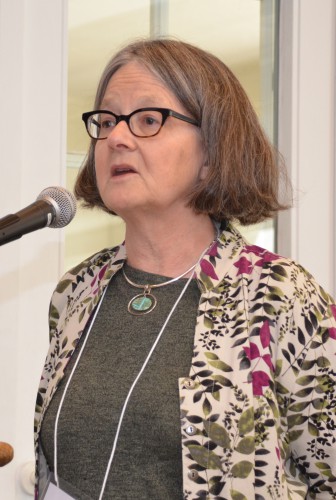Clinics without walls
Denver Health 21st century care
by Kate Alfano, CMS communications coordinator
Denver Health, a vertically integrated system that includes a large acute hospital, an emergency room, an emergency response system, the Department of Public Health, and a network of eight federally qualified health centers, received a $20 million Health Care Innovations grant from the federal Centers for Medicare and Medicaid Innovation nearly three years ago to transform its primary care delivery system to provide individualized care to more effectively meet patients’ medical, behavioral and social needs.
Have they succeeded? Simon Hambidge, MD, PhD, Denver Health’s chief ambulatory care officer and CEO of Denver Community Health Services, and Lucy Loomis, MD, presented data at the Spring Conference that indicates they have. In fact, the organization shows real progress in achieving the triple aim of improving access, improving health and lowering costs.

Simon Hambidge, MD, PhD
Through their 21st Century Care program, Denver Health provides team-based care, coordinates care across health settings, and offers self-care support between visits enabled by health information technology and team-based patient navigators who reach out to patients in a variety of ways. The program also integrates physical and behavioral health services in collaboration with the Mental Health Center of Denver in existing primary care settings and in newly created high-risk clinics for the most complex patients.
Last year Denver Health facilities treated nearly 140,000 patients, mostly Medicaid beneficiaries or uninsured, at over 430,000 visits. They had already determined that 1 percent of patients accounted for 22 percent of the health care costs and 50 percent accounted for 1 percent of costs. “If we want to be responsible in using our resources we want to understand what’s driving the excess costs in the higher utilizers and what we can do to help improve that,” said Loomis, who is director of family medicine at Denver Health. “It’s not all about money; certainly it’s nice to save some money but the goal is to actually improve the care for those patients.”

Lucy Loomis, MD
One key to bending the cost curve in primary care is to break down some of the silos, Loomis said, and care coordination is a way to reestablish the connections in a patient’s care. “You need to know your population and be able to identify who your high-risk patients are, and be able to develop services for them. Care coordination at this level means tracking patients, including when they receive services outside of your practice with the overall idea being to reduce care fragmentation.”
Hambidge described the process. To start, they determined their patient population to be any primary care patient, any of their Denver Managed Care patients even if they hadn’t been seen in the system, and frequent users of the emergency department and hospital. Then they stratified them, separating adults and children, into nine tiers from healthy to disastrously ill using 3M’s Clinical Risk Grouping (CRG) software. They decided to modify the CRG tools, which are based on past utilization, because they felt this metric alone wasn’t capturing everything. They also determined that they would translate nine CRG tiers into four clinical tiers, spending hours going line by line through thousands of lines of codes and diagnoses.
“This was really driven by the physicians involved in the process,” Hambidge said. “For instance, if you are a high utilizer and it hasn’t yet shown up on the CRGs, we’re going to make sure you get seen sooner rather than later. If you were on the registry for kids with special needs, we didn’t care if you hadn’t been seen in our system; we’re going to put you in the highest tier so you can get care coordination. So we overrode some clinical common sense into the tool.”
The higher the tier, the more likely an override has been applied. “By the time you are a tier 4 kid, half of those are assigned by utilization of CRGs and half are assigned by being on the special needs registry or having a mental health diagnosis,” he said. “If you split out our inpatient, outpatient, professional and other costs and look at the tiers, it looks like it’s working. We felt we could move ahead with this scheme; we had identified higher-cost populations and also populations that we felt were clinically more at risk so it felt good from a clinical and cost perspective.”
After risk stratifying the adults and children into two pyramids, they assigned clinical services to each of the tiers. Tier one, the largest group representing the healthy patients, basically received standard care plus text message reminders of vaccinations or well visits. For tier 2 patients, they rolled in patient navigators for the management of stable chronic disease, as well as behavioral health consultants. Tier 3 pediatric patients had access to nurse care coordinators and tier 3 adults had access to clinical pharmacists.
For tier 4 patients, they set up specialized clinics. For example, they had a multidisciplinary clinic for kids with special health care needs and an intensive outpatient clinic for adult high utilizers with serious mental and medical disease. This ambulatory ICU was located near the emergency department and allowed these patients to be treated more in an ambulatory setting.
To support the enhanced care coordination services and boost team-based care, they integrated new staff into the clinics, the patient navigators, more pediatric nurses and clinical pharmacists, and behavioral health consultants. “It’s a lot of phone calls,” Hambidge said. Before a tier 4 child comes into the clinic, the nurse does pre-visit work: Checking on the referral, reviewing the chart, making sure the problem list is up to date, and conducting a case conference by phone. At the visit they have a multispecialty consult, if necessary, and develop a detailed care plan with the family. After the visit, staff reviews additional referrals, the care plan and care transitions.
The original cost savings goal was 2.5 percent relative to trend; overall savings in 2013 alone was $7.5 million or 2.7 percent, Hambidge said. Most of this, $4.8 million, came through tier 4 adults – Medicaid dual eligible patients who used the ambulatory ICU – but they also achieved $1.3 million in cost savings with the tier 4 children, likely from increased access to providers over the phone as they didn’t have to go to the emergency department as much.
“It’s time-consuming, it’s difficult to get there, but it’s really rewarding,” Hambidge said. “I don’t have data on physician satisfaction but I can tell you anecdotally that it’s extremely high because when they see their most complex patients, they now have something they can do with them. They’re no longer spinning their wheels trying to figure out how to help this really complex patient.”
With the grant coming to a close, Hambidge said their actuaries and finance department believe targeting intensive care coordination services may support a sustaining care model. They’re conducting experimental analyses to try to figure out the most valuable parts of the program to continue to achieve high patient and physician satisfaction and reduce overall health care costs.
Posted in: Colorado Medicine | Practice Evolution | Payment Reform | Practice Redesign | Medical Neighborhood/PCMH

Comments
Please sign in to view or post comments.